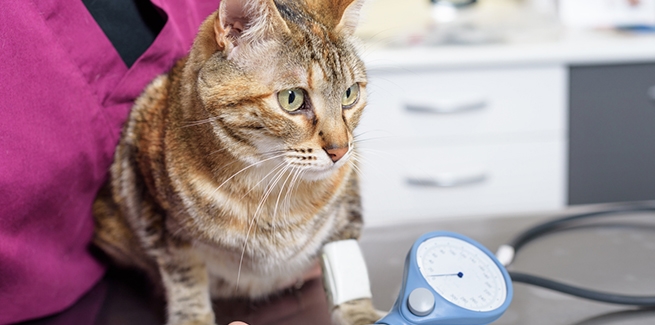How often are you taking your feline patients’ blood pressure?

Odds are, not often enough.
That’s according to a new survey of cat owners in the United Kingdom.
The survey, carried out by Ceva Animal Health to coincide with Feline Hypertension Month, which runs until the end of May, revealed that cat owners view taking blood pressure as the most important check a physician can carry out in older human patients. Yet only 20% of owners whose cats are seven years or older say their veterinarian has suggested a blood pressure check, even though the International Society of Feline Medicine recommends that veterinarians perform annual blood pressure checks in cats starting at age seven.
Hypertension occurs commonly in aged cats, most notably those with chronic kidney disease (CKD). In fact, hypertension has been documented in up to 65% of cats with CKD, so it’s critical for practitioners to monitor blood pressure in their feline patients on a regular basis after they reach seven years of age. This is particularly true for cats with recognized risk factors, including CKD, hyperthyroidism, hyperadrenocorticism, or evidence of target organ damage.
The survey showed that 80% of respondents didn’t know that cats could have high blood pressure and nearly 20% thought it was only a problem for humans. As for cat owners who were aware of feline hypertension, only one-quarter said they would consider asking their veterinarian to check their cat’s blood pressure.
However, once cat owners were made aware of the risks of high blood pressure, such as blindness, seizures, and kidney disease, 83% said they would ask their for a blood pressure test for their cat.
Clearly, the interest is there.
NEWStat contacted Scott Brown, VMD, PhD, DACVIM (Small Animal Internal Medicine), associate dean for academic affairs at the University of Georgia’s College of Veterinary Medicine and a coauthor of a recent article on best practices for treating systemic hypertension in dogs and cats, to ask how the profession can help veterinarians be more proactive in doing blood pressure checks.
Brown said that educating the profession about feline hypertension can “make its prevalence and value of treatment more well known” through expert continuing education at professional meetings and workshops, and by providing “clear, actionable guidelines” through industry organizations such as the International Renal Interest Society and the American College of Veterinary Internal Medicine.
Brown added that the advantages of doing more frequent blood pressure checks include helping veterinarians more accurately pinpoint each feline patient’s baseline, as well as enabe earlier diagnosis of chronic kidney disease and hyperthyroidism.
NEWStat asked Brown if there was any new research on systemic hypertension in cats that veterinarians should be aware of.
“Telmisartan as an effective agent,” Brown said, adding that the blood pressure medication “joins amlodipine as an agent of value [but] with a different mechanism of action.”
Brown also suggested that both drugs might be useful when used in combination.
Photo credit: © iStock/herraez



